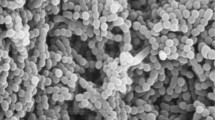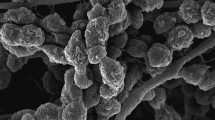Abstract
A novel halophilic actinomycete, strain H32T, was isolated from a Saharan soil sample collected in El-Oued province, south Algeria. The isolate was characterized by means of polyphasic taxonomy. Optimal growth was determined to occur at 28–32 °C, pH 6.0–7.0 and in the presence of 15–25 % (w/v) NaCl. The strain was observed to produce abundant aerial mycelium, which formed long chains of rod-shaped spores at maturity, and fragmented substrate mycelium. The cell wall was determined to contain meso-diaminopimelic acid and the characteristic whole-cell sugars were arabinose and galactose. The predominant menaquinones were found to be MK-10(H4) and MK-9(H4). The predominant cellular fatty acids were determined to be anteiso C17:0, iso-C15:0 and iso-C16:0. The diagnostic phospholipid detected was phosphatidylcholine. Phylogenetic analyses based on the 16S rRNA gene sequence showed that this strain formed a distinct phyletic line within the radiation of the genus Actinopolyspora. The 16S rRNA gene sequence similarity indicated that strain H32T was most closely related to ‘Actinopolyspora algeriensis’ DSM 45476T (98.8 %) and Actinopolyspora halophila DSM 43834T (98.5 %). Furthermore, the result of DNA–DNA hybridization between strain H32T and the type strains ‘A. algeriensis’ DSM 45476T, A. halophila DSM 43834T and Actinopolyspora mortivallis DSM 44261T demonstrated that this isolate represents a different genomic species in the genus Actinopolyspora. Moreover, the physiological and biochemical data allowed the differentiation of strain H32T from its closest phylogenetic neighbours. Therefore, it is proposed that strain H32T represents a novel species of the genus Actinopolyspora, for which the name Actinopolyspora saharensis sp. nov. is proposed. The type strain is H32T (=DSM 45459T=CCUG 62966T).


Similar content being viewed by others
References
Becker B, Lechevalier MP, Gordon RE, Lechevalier HA (1964) Rapid differentiation between Nocardia and Streptomyces by paper chromatography of whole-cell hydrolysates. J Appl Microbiol 12:421–423
Chun J, Bae KS, Moon EY, Jung SO, Lee HK, kim SJ (2000) Nocardiopsis kunsanensis sp. nov., a moderately halophilic actinomycete isolated from a saltern. Int J Syst Evol Microbiol 50:1909–1913
De Ley J, Cattoir H, Reynaerts A (1970) The quantitative measurement of DNA hybridization from renaturation rates. Eur J Biochem 12:133–142
Felsenstein J (1981) Evolutionary trees from DNA sequences: a maximum likelihood approach. J Mol Evol 17:368–376
Felsenstein J (1985) Confidence limits on phylogenies: an approach using the bootstrap. Evolution 39:783–791
Fitch WM (1977) On the problem of discovering the most parsimonious tree. Am Nat 111:223–257
Gochnauer MB, Leppard GG, Komaratat P, Kates M, Novitsky T, Kushner DJ (1975) Isolation and characterization of Actinopolyspora halophila, gen. sp. nov., an extremely halophilic actinomycete. Can J Microbiol 2:1500–1511
Gochnauer MB, Johnson KG, Kushner DJ (1989) Genus Actinopolyspora. In: Williams ST, Sharpe ME, Holt JG (eds) Bergey’s manual of systematic bacteriology, vol 4. Williams and Wilkins, Baltimore, pp 2398–2401
Goodfellow M (1971) Numerical taxonomy of some nocardioform bacteria. J Gen Microbiol 69:33–90
Gordon RE, Barnett DA (1977) Resistance to rifampicin and lysozyme of strains of some species of Mycobacterium and Nocardia as a taxonomic tool. Int J Syst Bacteriol 27:176–178
Gordon RE, Barnett DA, Handerhan JE, Pang CHN (1974) Nocardia coeliaca, Nocardia autotrophica, and the nocardin strain. Int J Syst Bacteriol 24:54–63
Guan TW, Liu Y, Zhao K, Xia ZF, Zhang XP, Zhang LL (2010) Actinopolyspora xinjiangensis sp. nov., a novel extremely halophilic actinomycete isolated from a salt lake in Xinjiang, China. Antonie Leeuwenhoek 98:447–453
Hayakawa M, Nonomura H (1987) Humic acid-vitamin agar, a new medium for the selective isolation of soil actinomycetes. J Ferment Technol 65:501–509
Hozzein WN, Goodfellow M (2011) Actinopolyspora egyptensis sp. nov., a new halophilic actinomycete. Afr J Microbiol Res 5:100–105
Huss VAR, Festl H, Schleifer KH (1983) Studies on the spectrophotometric determination of DNA hybridization from renaturation rates. Syst Appl Microbiol 4:184–192
Jukes TH, Cantor CR (1969) Evolution of protein molecules. In: Munro HN (ed) Mammalian protein metabolism, vol 3. Academic Press, New York, pp 21–132
Kelly KL, Judd DB (1976) Color. Universal language and dictionary of names (National Bureau of Standards special publication 440). US Department of Commerce, Washington, DC
Kim OS, Cho YJ, Lee K, Yoon SH, Kim M, Na H, Park SC, Jeon YS, Lee JH, Yi H, Won S, Chun J (2012) Introducing EzTaxon-e: a prokaryotic 16S rRNA gene sequence database with phylotypes that represent uncultured species. Int J Syst Evol Microbiol 62:716–721
Kimura M (1980) A simple method for estimating evolutionary rates of base substitutions through comparative studies of nucleotide sequences. J Mol Evol 16:111–120
Kroppenstedt RM (1982) Separation of bacterial menaquinones by HPLC using reverse phase (RP18) and a silver loaded ion exchanger as stationary phases. J Liq Chromatogr 5:2359–2367
Kroppenstedt RM (1985) Fatty acid and menaquinone analysis of actinomycetes and related organisms. In: Goodfellow M, Minnikin DE (eds) Chemical methods in bacterial systematics. Academic Press, London, pp 173–179
Larkin MA, Blackshields G, Brown NP, Chenna R, McGettigan PA, McWilliam H, Valentin F, Wallace IM, Wilm A, Lopez R, Thompson JD, Gibson TJ, Higgins DG (2007) CLUSTALW and CLUSTALX version 2. Bioinformatics 23:2947–2948
Lechevalier MP, Lechevalier HA (1970) Chemical composition as a criterion in the classification of aerobic actinomycetes. Int J Syst Bacteriol 34:435–444
Lechevalier MP, de Bièvre C, Lechevalier HA (1977) Chemotaxonomy of aerobic actinomycetes: phospholipid composition. Biochem Syst Ecol 5:249–260
Liu D, Coloe S, Baird R, Pedersen J (2000) Rapid mini-preparation of fungal DNA for PCR. J Clin Microbiol 38:471
Marchal N, Bourdon JL, Richard CL (1987) Les milieux de culture pour l’isolement et l’identification biochimique des bactéries. Doin Press, Paris
Meklat A, Zitouni A, Mathieu F, Lebrihi A, Sabaou N (2011) Halophilic actinomycetes in Saharan soils of Algeria: isolation, taxonomy and antagonistic properties. Appl Environ Microbiol 77:6710–6714
Meklat A, Bouras N, Zitouni A, Mathieu F, Lebrihi A, Schumann P, Spröer C, Klenk HP, Sabaou N (2012) Actinopolyspora algeriensis sp. nov., a novel halophilic actinomycete isolated from a Saharan soil. Extremophiles 16:771–776
Minnikin DE, O’Donnell AG (1984) Actinomycete envelope lipid and peptidoglycan composition. In: Goodfellow M, Mordarski M, Williams ST (eds) The biology of the actinomycetes. Academic Press, London, pp 337–388
Minnikin DE, Patel PV, Alshamaony L, Goodfellow M (1977) Polar lipid composition in the classification of Nocardia and related bacteria. Int J Syst Bacteriol 27:104–117
Rainey FA, Ward-Rainey N, Kroppenstedt RM, Stackebrandt E (1996) The genus Nocardiopsis represents a phylogenetically coherent taxon and a distinct actinomycete lineage: proposal of Nocardiopsaceae fam. nov. Int J Syst Bacteriol 46:1088–1092
Saitou N, Nei M (1987) The neighbor-joining method: a new method for reconstructing phylogenetic trees. Mol Biol Evol 4:406–425
Sasser M (1990) Identification of bacteria by gas chromatography of cellular fatty acids. Technical note 101. Microbial ID, Newark
Shirling EB, Gottlieb D (1966) Methods for characterization of Streptomyces species. Int J Syst Bacteriol 16:313–340
Tang SK, Wang Y, Klenk HP, Shi R, Lou K, Zhang YJ, Chen C, Ruan JS, Li WJ (2011) Actinopolyspora alba sp. nov. and Actinopolyspora erythraea sp. nov., isolated from a salt field, and reclassification of Actinopolyspora iraqiensis Ruan et al. 1994 as a heterotypic synonym of Saccharomonospora halophila. Int J Syst Evol Microbiol 61:1693–1698
Waksman SA (1961) Classification, identification, and descriptions of genera and species. In: The actinomycetes, vol 2. Williams & Wilkins, Baltimore, pp 331–332
Wayne LG, Brenner DJ, Colwell RR, Grimont PAD, Kandler O, Krichevsky MI, Moore LH, Moore WEC, Murray RGE, Stackebrandt E, Starr MP, Trüper HG (1987) International committee on systematic bacteriology. Report of the ad hoc committee on the reconciliation of approaches to bacterial systematic. Int J Syst Bacteriol 37:463–464
Xu P, Li WJ, Tang SK, Zhang YQ, Chen GZ, Chen HH, Xu LH, Jiang CL (2005) Naxibacter alkalitolerans gen. nov., sp. nov., a novel member of the family ‘Oxalobacteraceae’ isolated from China. Int J Syst Evol Microbiol 55:1149–1153
Yoshida M, Matsubara K, Kudo T, Horikoshi K (1991) Actinopolyspora mortivallis sp. nov., a moderately halophilic actinomycete. Int J Syst Bacteriol 41:15–20
Acknowledgments
The authors are grateful to Khaled Kherraz for soil sampling from El-Oued province, Gabriele Pötter (DSMZ) for growing A. saharensis cultures and for assistance with chemotaxonomical analyses and Bettina Sträubler for assistance with DNA–DNA hybridizations.
Author information
Authors and Affiliations
Corresponding author
Electronic supplementary material
Below is the link to the electronic supplementary material.
Rights and permissions
About this article
Cite this article
Meklat, A., Bouras, N., Zitouni, A. et al. Actinopolyspora saharensis sp. nov., a novel halophilic actinomycete isolated from a Saharan soil of Algeria. Antonie van Leeuwenhoek 103, 771–776 (2013). https://doi.org/10.1007/s10482-012-9859-z
Received:
Accepted:
Published:
Issue Date:
DOI: https://doi.org/10.1007/s10482-012-9859-z




